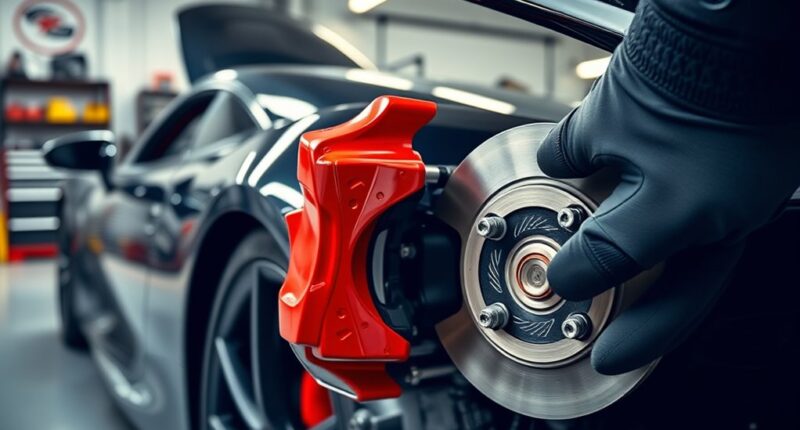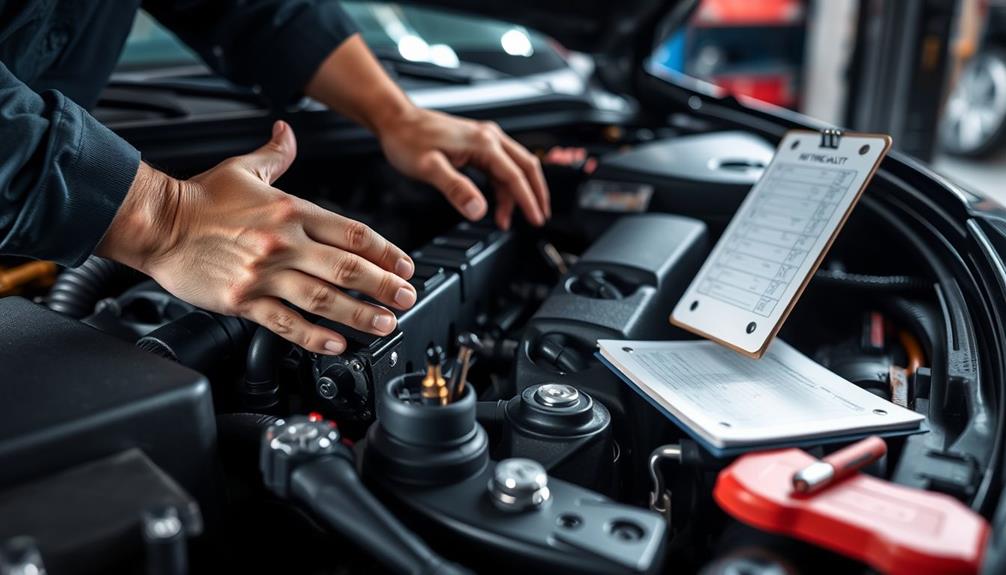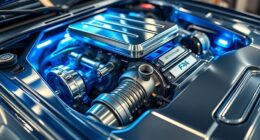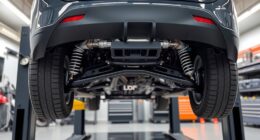To improve your car’s braking performance, start by evaluating your current system for any wear or fluid issues. Upgrade to high-quality brake components like performance rotors, pads, and braided lines, and consider larger, vented rotors for better cooling. Fine-tune brake bias and regularly maintain your system to prevent moisture buildup. Practice smooth braking techniques and use proper tools for testing and calibration. Keep exploring these strategies to reveal your vehicle’s best stopping power.
Key Takeaways
- Upgrade to high-quality brake components, including larger rotors, multi-piston calipers, and high-performance pads for better heat management.
- Use braided stainless steel brake lines and DOT 5.1 fluid to improve pedal feel and prevent fluid boiling under high temperatures.
- Fine-tune brake bias with proportioning valves or bias bars, starting with a 75% front bias and adjusting based on lockup behavior.
- Enhance cooling by installing brake ducts, vented rotors, and improving vane design to prevent fade during aggressive braking.
- Regularly test and analyze braking performance using data collection tools, adjusting components and bias for optimal safety and responsiveness.
Assess Your Current Brake System Setup
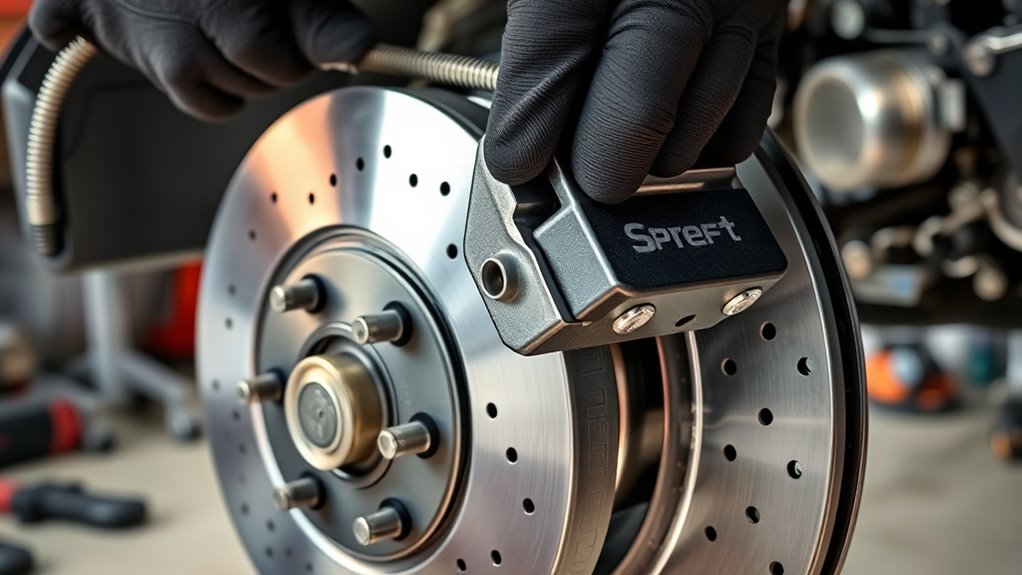
Before tuning your car’s brake system, it’s essential to assess its current setup thoroughly. Begin by inspecting the brake fluid’s condition—check its viscosity, color, and moisture content. This helps determine if the fluid needs replacing or flushing. Contaminants in brake fluid can cause caliper piston binding and shorten brake pad life. Next, examine the master cylinder, ensuring the reservoir is at the correct level and the float is functioning properly. Look for leaks anywhere in the system, as fluid loss hampers braking performance. Use a pressure gauge to verify brake fluid pressure and a load cell attached to the brake pedal to measure pressure and displacement. Also, inspect brake pads and rotors for excessive wear or warping. Regular brake system inspections are crucial for maintaining optimal performance. Clean components as needed to remove debris, ensuring accurate assessment and a solid foundation for any future upgrades or adjustments.
Upgrade to High-Performance Brake Components

Upgrading to high-performance brake components is a crucial step in enhancing your vehicle’s stopping power and overall braking feel. High-quality rotors, pads, and calipers improve heat dissipation, reduce brake fade, and provide more consistent performance. Distributor of High Performance Brake Systems offers a wide range of these components from top brands to ensure optimal quality. Consider options like two-piece GiroDisc rotors for better cooling and reduced unsprung weight, or Bosch QuietCast rotors for reliable operation. Upgrading to high-performance brake pads from EBC or Bosch ensures quieter operation and longer life. Big brake kits with larger rotors and multi-piston calipers dramatically increase stopping power, especially during high-speed driving. Specialized calipers from Wilwood or GiroDisc offer enhanced heat management and lighter weight, while full floating rotors improve brake modulation and cooling. These upgrades make a noticeable difference on the road or track. Additionally, selecting components with high efficiency ratings can further optimize your braking system’s performance and longevity. Incorporating braking system upgrades that enhance heat dissipation and reduce fade can lead to more consistent braking under demanding conditions.
Optimize Brake Line and Fluid Choices

Choosing the right brake lines and fluid can substantially boost your vehicle’s braking performance. Upgrading to braided stainless steel lines reduces swelling, providing a firmer pedal feel and consistent pressure. These lines are more durable and flexible, ideal for racing or aggressive driving. In contrast, copper-nickel lines are easier to install and cheaper but less durable against impacts. Kia Tuning options often include high-performance brake components suitable for various driving styles. For brake fluid, opt for DOT 5.1 for higher boiling points, especially in high-performance or racing setups. Regularly check and replace fluid to prevent moisture buildup and maintain *ideal* braking. Additionally, understanding braking system upgrades can help you select the most effective components for your specific needs.
Enhance Rotor Cooling and Ventilation
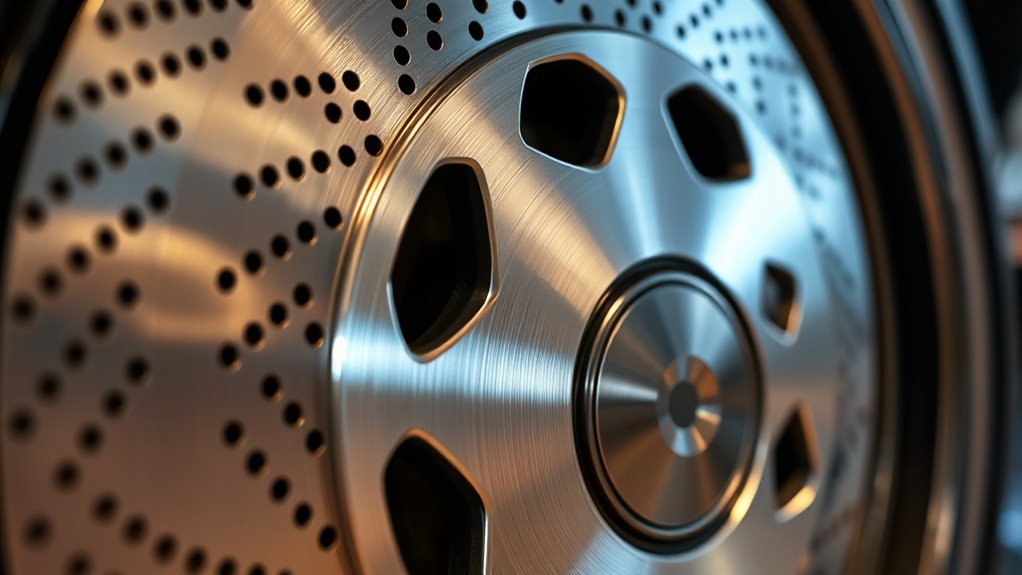
Enhancing rotor cooling and ventilation is essential for maintaining ideal braking performance under demanding conditions. Proper airflow prevents excessive heat buildup, reduces thermal stresses, and extends rotor and pad lifespan.
To maximize cooling, consider installing brake cooling ducts that channel cool air directly to the rotors, especially in high-performance setups. Vented rotors increase surface area, allowing better heat exchange with air. In addition, selecting water-cooled brake systems can further improve thermal management during intense driving sessions.
Optimizing vane designs can improve airflow within the rotor, aiding heat dissipation. Using computational fluid dynamics (CFD) helps analyze airflow patterns for precise improvements.
Additionally, ensuring smooth airflow and reducing turbulence around the rotor are key. Regularly inspecting and maintaining cooling components guarantees consistent performance, preventing overheating and maintaining braking efficiency under intense driving conditions. Proper filtration of cooling system components helps prevent debris buildup that can impair airflow and cooling efficiency
Adjust Brake Bias for Better Distribution

Have you ever wondered how to optimize your car’s stopping power and stability during hard braking? Adjusting brake bias is key. It controls how much force is applied to the front and rear brakes, affecting stability and control. Brake bias is the ratio of braking force between rear and front brakes. Typically, starting with a front-heavy bias (around 75%) helps prevent rear lockup, which can cause spins. Use bias bars or proportioning valves to fine-tune this distribution—clockwise adjustments usually increase front bias, while rotating valves reduce rear force. Test on a safe, controlled surface, gradually increasing speed and monitoring lockup behavior. Small adjustments of 2-5% can considerably improve balance. Additionally, understanding the vehicle’s weight distribution can help in setting the most effective brake bias for your specific car setup. Proper braking system maintenance and calibration are also essential for consistent performance.
Implement Proper Brake Maintenance Routines
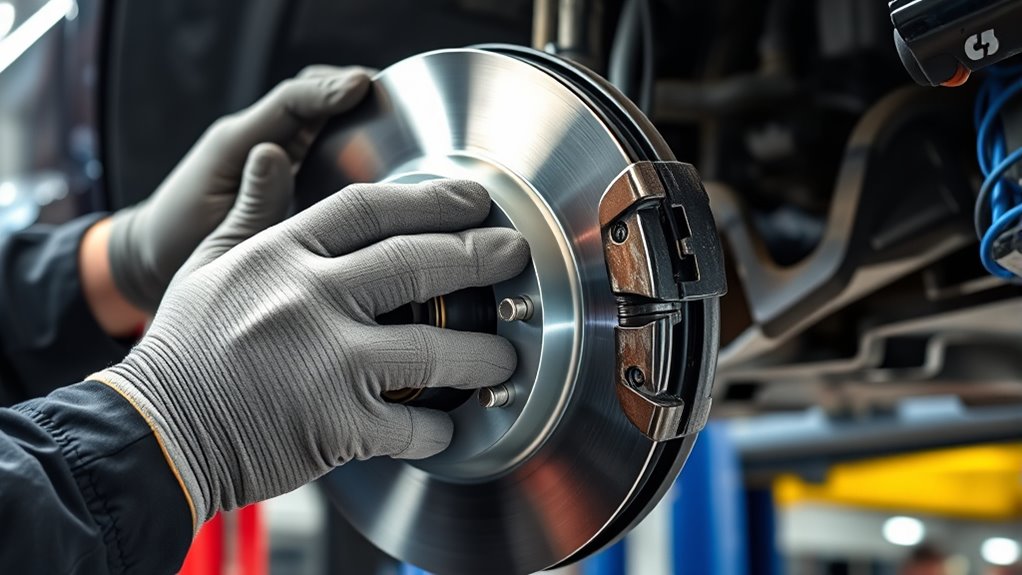
Maintaining your brake system is just as important as fine-tuning brake bias for ideal performance. Regular inspections help catch issues early, preventing costly repairs and ensuring safety. Visual checks of brake pads, rotors, and calipers reveal wear, while listening for squeals or vibrations can pinpoint problems like warped rotors or worn pads. Data analytics can assist in tracking vehicle maintenance patterns, helping you schedule timely inspections. Monitoring brake fluid levels and appearance helps avoid moisture contamination that reduces braking efficiency. Following your owner’s manual for scheduled checks keeps your system in top shape. Consistent maintenance extends brake lifespan and improves responsiveness.
- Check brake pads for thickness and replace when worn
- Inspect rotors for grooves, cracks, or warping
- Regularly test brake fluid levels and replace as needed
- Clean brake components with dedicated brake cleaner
Regular brake inspections ensure that any issues are identified early, maintaining optimal braking performance and safety.
Adopt Driving Techniques to Maximize Braking Efficiency

Adopting effective driving techniques is essential to maximize your vehicle’s braking efficiency. Start by smoothly switching from the throttle to the brake, minimizing delay to reduce time loss. Gradually increase brake pressure to prevent sudden weight transfer and maintain traction, and learn your vehicle’s brake response to avoid lock-ups. Braking generates the highest G-force in track cars, making it crucial for time gains. Practice precise footwork to eliminate inefficient pedal movements and focus on early visual cues, like turn-in markers, to optimize braking zones. Avoid slamming the brakes; instead, modulate pedal pressure based on tire grip and surface conditions. Use threshold braking techniques to stay near traction limits and monitor brake temperature to prevent fade. Maintaining consistent speeds, anticipating traffic, and increasing following distance also help you brake more effectively, reducing unnecessary stress on your braking system.
Regularly Test and Fine-Tune Your Braking System
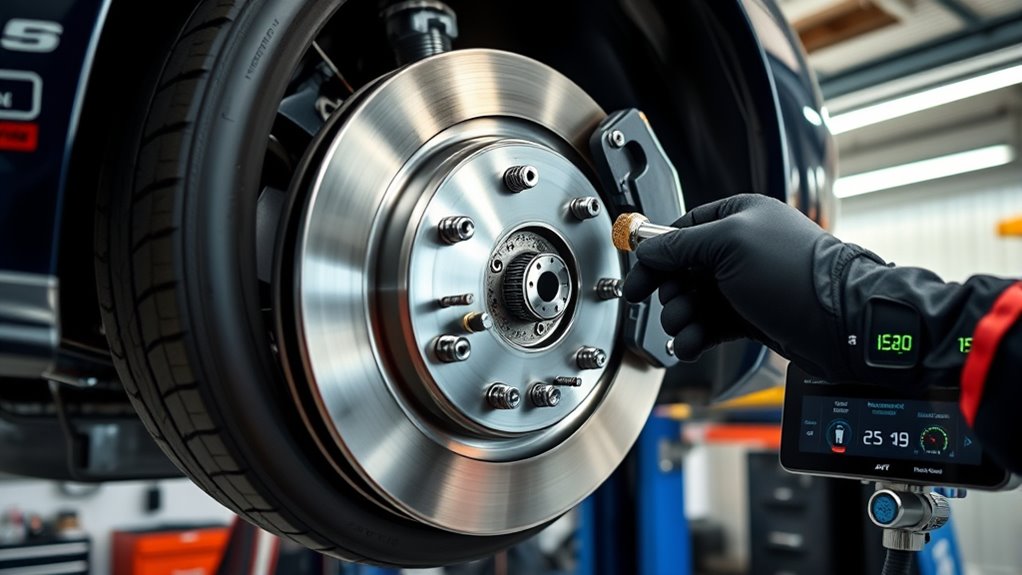
To guarantee your braking system performs at its best, it’s important to regularly test and fine-tune it based on accurate data. Consistent testing helps identify issues early and ensures ideal performance under various conditions. Use standardized protocols like ECE, ISO, or FMVSS for repeatable results. Conduct dry and wet asphalt tests with ABS on and off to isolate variables. Measure braking distance with high-precision GPS or inertial systems. Adjust brake balance based on force distribution data, re-calibrate ABS and ESC systems after modifications, and verify environmental factors like temperature. To further enhance safety and reliability, incorporate advanced testing technologies such as test benches that allow for controlled, repeatable testing environments. – Install performance-based brake testers (PBBT) for dynamic force measurement – Use roller dynamometers or flat plate testers for force analysis – Incorporate real-time data visualization for instant feedback – Perform follow-up tests every 500-1,000 miles
Frequently Asked Questions
What Are the Best Brake Pad Materials for Street and Track Use?
When choosing brake pads for street and track use, you want materials that balance performance, durability, and noise levels. Organic pads are quiet and good for city driving but fade under high heat.
Semi-metallic pads handle aggressive driving and high temperatures better, making them suitable for track days.
For the best of both worlds, track-oriented compounds provide high heat resistance and reliable initial bite, ideal for dual-use vehicles.
How Does Brake Fluid Temperature Affect Braking Performance?
Did you know that brake fluid boiling points over 300°C are common in racing fluids? When brake fluid heats up beyond its boiling point, vapor forms in the lines, causing spongy brakes and reduced stopping power.
High temperatures lower fluid effectiveness, leading to brake fade and component damage. To keep performance ideal, regularly check your brake fluid, avoid overheating, and consider high-temperature fluids for demanding driving.
Can Brake Bias Adjustment Improve Handling During Aggressive Driving?
Adjusting your brake bias can definitely improve handling during aggressive driving. By fine-tuning the distribution of braking force between front and rear wheels, you can enhance stability and cornering control.
Moving the bias forward increases responsiveness and reduces stopping distances, while shifting it rearward improves stability during sharp maneuvers.
Experiment with small adjustments to find the balance that suits your driving style, ensuring safer, more confident performance on the track.
What Signs Indicate That Brake Components Need Replacement or Upgrade?
Beware of worn-out warnings like squealing sounds, grinding noises, or a spongy pedal, signaling your brake pads need replacing.
Feel for vibrations or pulsations, which suggest warped rotors, or notice leaks and low fluid, indicating fluid issues.
Uneven braking or pulling, increased stopping distances, and warning lights also point to failing components.
If these signs appear, upgrade or replace your brakes to guarantee safety and peak performance.
How Does Vehicle Weight Distribution Influence Brake System Tuning?
Vehicle weight distribution plays a key role in brake system tuning because it determines how much braking force each axle needs. If most of the weight is over the front, you’ll want stronger front brakes and balanced rear brakes to prevent uneven stopping.
Adjusting brake bias guarantees effective deceleration, reduces fade, and maintains stability during braking, especially when handling different driving conditions or modifications to your vehicle’s weight setup.
Conclusion
By tuning your brakes, you’re releasing your car’s true potential—like sharpening a blade to cut through hesitation. Every upgrade and adjustment acts as a brushstroke, shaping your vehicle’s ability to stop on a dime. Remember, a well-tuned braking system isn’t just about safety; it’s about gaining confidence behind the wheel. Keep fine-tuning, testing, and practicing, and you’ll find your stopping power becomes a trusted partner in every drive.
